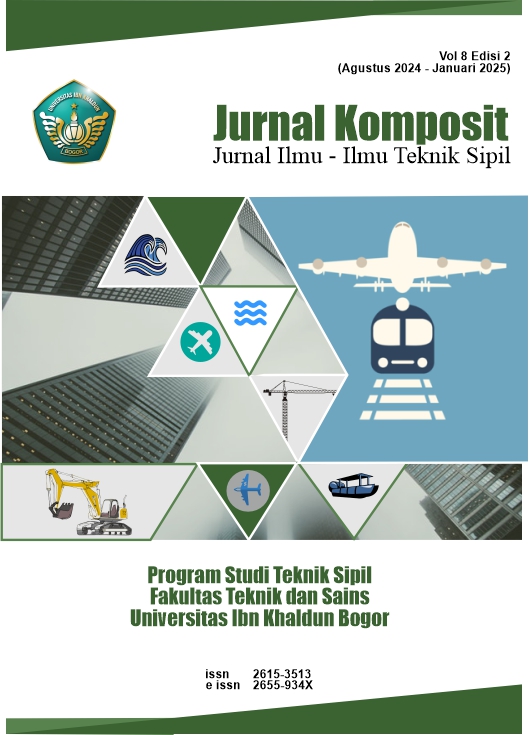Studi Kasus Pemodelan Vacuum Consolidation dan Prefabricated Vertical Drain
DOI:
https://doi.org/10.32832/komposit.v8i2.16500Keywords:
Prefabricated Vertical Drain, Vacuum Consolidation, Plaxis 2D, PenurunanAbstract
Soft soil is soil with the potential for large consolidation settlements over a long period of time. Soft soil often causes problems for the structures above it due to the relatively low bearing capacity of the subgrade and long-lasting large soil compression. To accelerate the consolidation reduction that occurs, one of the latest steps for soil improvement is the vacuum consolidation method with a combination of prefabricated vertical drain (PVD). This method involves installing a vertical drain into soft soil where a vacuum pump will suck water and air in the soil which has been wrapped in airtight material on top. The vacuum process and application of vertical drain will cause a decrease in consolidation in the soil to occur more quickly. Initial loading with vertical drainage is carried out to induce most of the settlement of the underlying soil layer. The aim of this research is to model the soil improvement process with vacuum and PVD using the 2-dimensional finite element method. The study was carried out by carrying out reverse analysis, based on soil parameter data in North Jakarta which was adjusted to the decline curve over time in the field. Based on the analysis, the results obtained show that with the presence of PVD, the soil permeability in the horizontal direction of the model will increase so that the dissipation of pore water pressure will be faster. Plaxis modeling curves for reduction over time and pore water pressure over time have similar results to measurements in the field.
References
Basu, D., & Madhav, M. (2000). Effect of Prefabricated Vertical Drain Clogging on the Rate of Consolidation: A Numerical Study. Geosynthetics International, 189-215.
Bo, M. W., Arulrajah, A., & Nikraz, H. (2007). Preloading and prefabricated vertical drains design for foreshore land reclamation projects: a case study. Ground Improvement, 67-76.
Chai, J., Carter, J. P., & Liu, M. D. (2014). Methods of vacuum consolidation and their deformation analyses. Ground Improvement, 35-46.
Chai, J., Miura, N., & Bergado, D. T. (2008). Preloading clayey deposit by vacuum pressure with cap-drain: Analyses versus performance. Geotextiles and Geomembranes 26, 220-230.
Indraratna, B., Bamunawita, C., Redana, I., & McIntosh, G. (2003). Modelling of prefabricated vertical drains in soft clay and evaluation of their effectiveness in practice. Ground Improvement, 127-137.
Punmia, B. C., Jain, A. K., & Jain, A. K. (2005). Soil Mechanics and Foundations. New Delhi: Laxmi Publications (P) LTD.
Rivanga, N. U., & Hamdhan, I. N. (2018). Analisis Vacuum Consolidation pada Perbaikan Tanah Lempung Lunak dengan Model Axisymmetric. Reka Racana, 68-79.
Schanz, T., Vermeer, P., & Bonnier, P. (1999). Formulation and verification of the Hardening-Soil Model. Beyond 2000 in Computational Geotechnics.
Taqwa, F. M. L., Hutabarat, L. E., Ilyas, T., & Prakoso, W. A. (2019). Estimation of settlement induced land subsidence of marine clay on Kamal Muara Area, Northern Jakarta, based on the change of pore water pressure. In Journal of Physics: Conference Series (Vol. 1376, No. 1, p. 012007). IOP Publishing.
Wani, K. M., & Showkat, R. (2018). Soil Constitutive Models and Their Application in Geotechnical Engineering: A Review. International Journal of Engineering Research & Technology, 137-145.
Downloads
Published
How to Cite
Issue
Section
License
Copyright (c) 2024 Jurnal Komposit: Jurnal Ilmu-ilmu Teknik Sipil

This work is licensed under a Creative Commons Attribution-NonCommercial-ShareAlike 4.0 International License.
Authors who publish with this journal agree to the following terms (Penulis yang mengajukan publikasi artikel telah menyetujui hal berikut):
- Through this publication, the author agree to submit the copyright of article writing to Jurnal Komposit: Jurnal Ilmu-ilmu Teknik Sipil. This copyright submission takes the form of, but is not limited to: reproduction of the article and parts therein, including photographic reproductions; distribution of articles through printed and electronic documents; and translation of articles(Bahwa melalui publikasi ini, hak cipta penulisan artikel diserahkan kepada Jurnal Komposit: Jurnal Ilmu-ilmu Teknik Sipil. Penyerahan hak cipta ini berupa, namun tidak terbatas pada: perbanyakan artikel dan bagian di dalamnya, termasuk reproduksi fotografi; penyebarluasan artikel melalui dokumen cetak dan elektronik; serta penterjemahan artikel).
- The authors agree to the terms of the Copyright Notice, according to Creative Commons Attribution-NonCommercial-ShareAlike 4.0 International License., which will apply to this article if and when it is published by Jurnal Komposit: Jurnal Ilmu-ilmu Teknik Sipil. (Para penulis setuju dengan ketentuan Pemberitahuan Hak Cipta, sesuai dengan Lisensi Internasional Creative Commons Attribution-NonCommercial-ShareAlike 4.0., yang akan berlaku untuk artikel ini jika dan ketika diterbitkan oleh Jurnal Komposit: Jurnal Ilmu-ilmu Teknik Sipil).

This work is licensed under a Creative Commons Attribution-NonCommercial-ShareAlike 4.0 International License.



.png)










